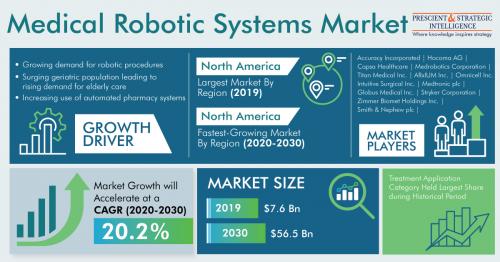Medical Robotic Systems Helping in Effective Distribution of Medicines

According to the World Population Ageing report of the United Nations (UN), the population of people aged 60 years and above will reach 2.1 billion by 2050 and 3.1 billion by 2100. The escalating financial burden, along with the scarcity of caregivers, necessitates finding a better way to care for the world’s geriatric pool. For instance, the elderly in Japan are so lonely that they often avail themselves of the Rent-A-Family service, wherein actors are hired to play the role of relatives. Researchers across the world are actively working to solve this issue and developing autonomous robots that can perform like human caregivers.
Moreover, the increasing usage of automated pharmacy systems will drive the medical robotic systems market at a healthy CAGR of 20.2% during the forecast period. The market generated $7.6 billion in 2019, and it has the potential to reach $56.5 billion by 2030. The adoption of these systems reduces the time required to find the prescribed drug at pharmacies and enables pharmacists and technicians to have more time for patients. Other advantages of medical robotic systems include reduced dispensing errors, lesser patient waiting time, and freeing up of space in pharmacies.
On the other hand, hospitals across the world have started adopting robotic systems for surgeries, due to the rising awareness about minimally invasive surgeries (MISs). According to a 2020 study in the Journal of the American Medical Association (JAMA), of all the general surgeries performed in 2018, 15.1% involved robots. The study indicates that inguinal hernia repair accounted for the highest utilization of medical robotic systems. Apart from automated dispensers and surgical robotic systems, medical professionals use rehabilitation, radiosurgery, and other types of robotic systems.
Make inquiry before purchase of this report: https://www.psmarketresearch.com/send-enquiry?enquiry-url=medical-robotic-systems-market
Further, the end user segment of the medical robotic systems market is categorized into pharmacies, hospitals and ambulatory surgery centers (ASCs), rehabilitation centers, and others. Under this segment, the hospitals and ASCs category accounted for the largest market share during the historical period (2014–2019), and it is projected to continue its dominance throughout the forecast period. This is due to the high quality of the care provided at these facilities, surging deployment of technologically advanced medical equipment, and vast number of patients visiting hospitals and ASCs.
These end users adopt robotic systems for automation in the areas of urology, gynecology, cardiothoracic surgery, orthopedics, and neurosurgery. Due to the growing cases of cardiovascular diseases (CVDs), the adoption of robots in the cardiothoracic field of medical sciences is increasing at a high pace, as robotic procedures offer high accuracy and require less time. According to the World Health Organization (WHO), the number of CVD deaths will reach nearly 23.6 million by 2030 from around 17.9 million presently. This clearly reflects a growing need for open and robotic heart surgeries, around the world.
Globally, North America is expected to dominate the medical robotic systems market over the forecast period, while also progressing at the highest rate. This can be ascribed to the presence of leading market players and a well-structured healthcare system. Moreover, the increasing funding from the government to develop medical robots and spurring demand for MISs will act as the catalysts for the market growth. Additionally, players in North America are focusing on strategic developments and raising funds to gain a leading position in the market.
Thus, the surging volume of MISs and prevalence of CVDs on account of the booming aging population will amplify the usage of robotic systems in the medical field. Moreover, the ease of dispensing pharmacy products offered by the automated process will boost the adoption of such systems in the coming years.
Advertise on APSense
This advertising space is available.
Post Your Ad Here
Post Your Ad Here
Comments